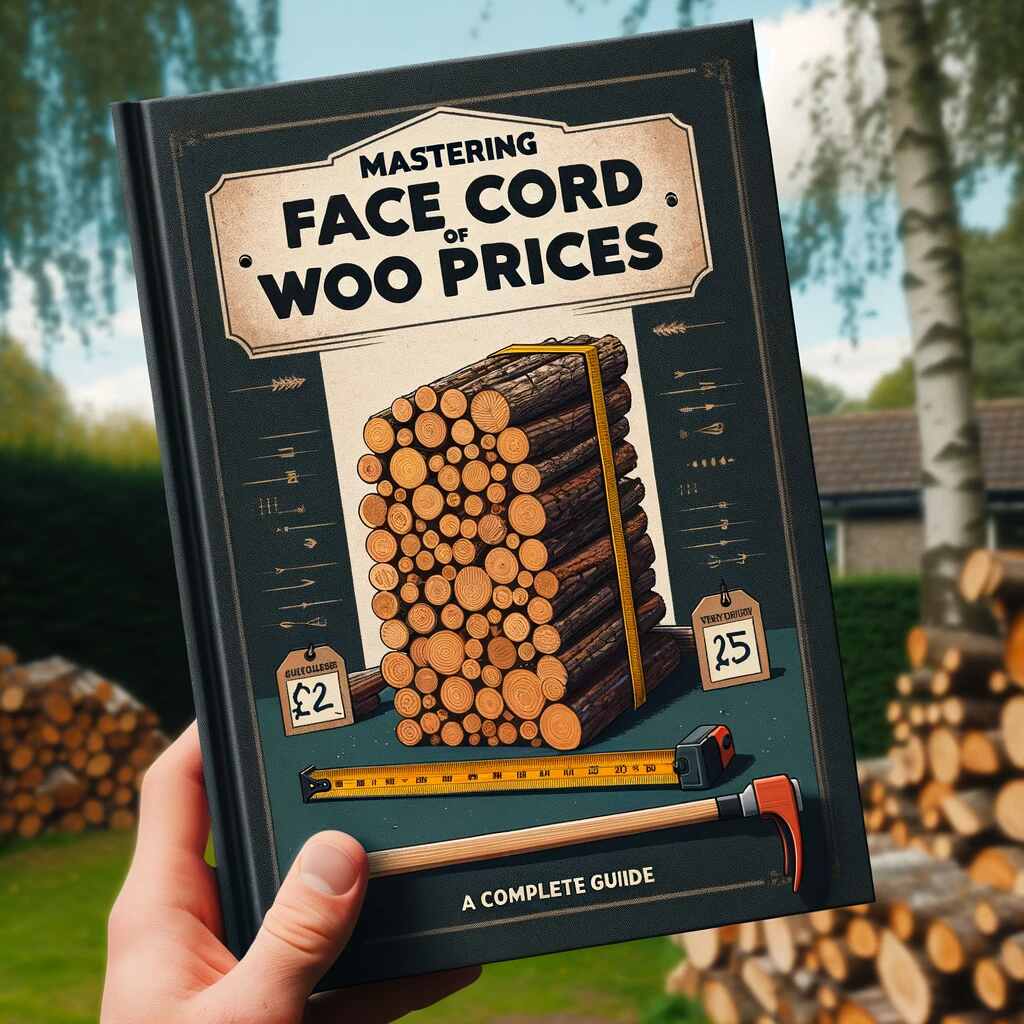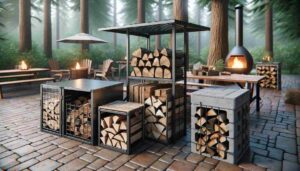If you’re in the market for firewood, whether it’s for heating your home, fueling your fireplace, or enhancing your outdoor cooking experience, understanding face cord wood prices is essential. Face cords are a common unit of measurement for firewood, and knowing how to calculate their cost and find the best deals can save you both money and hassle.
A face cord is equivalent to 42 cubic feet and can weigh between 830 to 1,700 lbs. On average, the price of a face cord of wood ranges from $100 to $250, with factors like wood type, quality, and location influencing the cost.
In this comprehensive guide, we’ll delve into all aspects of face cord wood prices, helping you make informed decisions and satisfy your search intent for “face cord of wood price.”
What is a Face Cord of Wood?
A face cord of wood is a unit of measurement commonly used in the firewood industry. It consists of a single stack of firewood, typically 4 feet high, 8 feet long, and however deep the pieces of wood are cut. The depth of the stack can vary depending on the length of the logs or split wood, but it is usually about 16 inches deep. This is important to note because the depth can vary, and it’s one factor that can influence the price.
Face Cord vs. Full Cord: Understanding the Difference
To avoid confusion when buying firewood, it’s crucial to understand the distinction between a face cord and a full cord. A full cord of wood measures 4 feet high, 4 feet wide, and 8 feet long, resulting in a total volume of 128 cubic feet. In contrast, a face cord, as previously mentioned, is 4 feet high and 8 feet long but can have varying depths.
The key takeaway is that a face cord is typically one-third the volume of a full cord. This difference is crucial when comparing prices and understanding the value you’re getting for your money.
Factors Affecting Face Cord Wood Prices
Several factors influence the price of a face cord of wood. Understanding these factors can help you make informed decisions when purchasing firewood:
Wood Type: Different types of wood, such as oak, maple, cherry, and pine, have varying levels of quality and desirability for burning. Hardwoods like oak and maple tend to burn longer and produce more heat than softwoods like pine or fir, making them typically more expensive.
Seasoning: Seasoned wood, which has been allowed to dry for at least six months to a year, commands a higher price than green or unseasoned wood. Seasoned wood burns more efficiently and produces less creosote, reducing the risk of chimney fires.
Cut and Split: The size and uniformity of the wood pieces can affect the price. Smaller, uniformly cut and split pieces are often priced higher due to the labor involved in processing them.
Delivery: If the seller offers delivery services, this can impact the cost, especially if you’re ordering a substantial quantity.
Location: Prices can vary significantly by region due to factors like local supply and demand, transportation costs, and the availability of specific wood types.
Quantity Purchased: Buying in larger quantities, such as multiple face cords or full cords, may lead to volume discounts.
Quality: The overall quality of the firewood, including cleanliness, lack of rot, and minimal bark, can influence the price.
Calculating the Cost of a Face Cord of Wood
To calculate the cost of a face cord of wood, you need to consider the factors mentioned above and the pricing method used by the seller. Some common pricing methods include:
Per Face Cord: Sellers may provide a fixed price per face cord, which makes it straightforward to calculate the total cost. For example, if the price is $150 per face cord, buying two face cords would cost $300.
Per Cubic Foot: In some cases, sellers might price their firewood by the cubic foot. To calculate the cost, you’ll need to determine the volume of the face cord and then multiply it by the price per cubic foot.
Per Cord Equivalent: Some sellers price their face cords based on a “cord equivalent” value. To calculate the cost, you’ll need to determine how many face cords make up a full cord and then multiply the price per cord equivalent by that number.
Per Log: In rare cases, sellers may price individual logs. To determine the cost of a face cord, you’ll need to count the logs in the stack and multiply by the price per log.
It’s essential to clarify the pricing method with the seller to ensure you’re comparing prices accurately and getting a fair deal.
Where to Buy Face Cord Wood
There are several sources where you can purchase face cords of wood, each with its advantages and considerations:
Local Firewood Suppliers: Local firewood suppliers or farmers often offer face cords for sale. Buying locally can be convenient, and you may have the opportunity to inspect the wood quality in person.
Online Marketplaces: Websites and online marketplaces like Craigslist, Facebook Marketplace, or specialized firewood websites allow you to find sellers in your area. However, exercise caution and verify the quality and credibility of the seller when buying online.
Home Improvement Stores: Some home improvement stores, garden centers, or even grocery stores may sell face cords of firewood. While convenient, prices can vary, and you may have limited wood type choices.
Tree Removal Services: If you have a tree removal project on your property, you can inquire about purchasing the wood from the removed trees. This option can be cost-effective, but the wood may require seasoning.
Firewood Delivery Services: Some companies specialize in delivering seasoned firewood to your doorstep. While convenient, this option can be more expensive due to delivery fees.
Tips for Getting the Best Deal on Face Cord Wood
To ensure you get the best value for your money when buying a face cord of wood, consider these tips:
Buy in Bulk: Purchasing multiple face cords or a full cord can often lead to volume discounts, reducing the overall cost per face cord.
Season Your Own Wood: If you have the space and time, consider buying green or unseasoned wood at a lower price and season it yourself. This can save money in the long run.
Compare Prices: Shop around and compare prices from different sellers to find the best deal in your area.
Ask for References: If you’re buying from an unfamiliar seller, ask for references or check online reviews to ensure they provide quality firewood.
Inspect the Wood: Before purchasing, inspect the wood to ensure it’s clean, free of rot, and meets your quality standards.
Consider the Wood Type: While hardwoods are typically more expensive, they also burn longer and produce more heat. Evaluate your heating needs and choose the wood type accordingly.
Negotiate: Don’t be afraid to negotiate with the seller, especially if you’re buying in significant quantities.
Plan Ahead: Buying firewood during the off-season or before winter arrives can often result in lower prices.
Seasoned vs. Unseasoned Wood: Which Should You Choose?
One crucial decision you’ll need to make when buying firewood is whether to choose seasoned or unseasoned wood. Here’s a comparison to help you decide:
Seasoned Wood:
- Advantages:
- Burns more efficiently.
- Produces less creosote buildup, reducing the risk of chimney fires.
- Provides more heat.
- Disadvantages:
- Typically more expensive.
- May require advance planning and storage space for seasoning.
Unseasoned (Green) Wood:
- Advantages:
- Generally more affordable.
- Available year-round.
- Disadvantages:
- Burns less efficiently.
- Produces more creosote.
- May require several months of seasoning before use.
Ultimately, the choice between seasoned and unseasoned wood depends on your budget, patience, and heating needs. If you have the time and space to season wood yourself, buying unseasoned wood can be a cost-effective option.
Storing and Managing Your Face Cord of Wood
Once you’ve purchased your face cord of wood, proper storage and management are essential to ensure it remains in good condition and ready for use. Here are some tips:
Stacking: Stack your firewood in a well-ventilated area, off the ground, and away from structures to prevent moisture buildup and pests.
Covering: Use a tarp or firewood cover to protect your wood from rain and snow while allowing air circulation to continue drying the wood.
Elevate: Store your wood on pallets or a raised platform to keep it dry and prevent contact with the damp ground.
Rotate: Use a “first in, first out” system to ensure you’re using the oldest wood first, allowing the newer wood to continue seasoning.
Check for Pests: Periodically inspect your woodpile for signs of pests like termites or ants and take appropriate measures if necessary.
Proper Ventilation: Ensure that air can circulate freely around the woodpile to aid in drying and reduce the risk of mold or fungal growth.
Safety: Keep your woodpile a safe distance from your home and any flammable structures, such as sheds or fences.
Conclusion
In conclusion, the cost of a face cord of wood varies, with an average price ranging from $100 to $250. Factors such as wood type, quality, and location play a significant role in determining the final price. Whether you’re looking for premium hardwood or economical softwood, understanding these variables will help you make an informed decision when purchasing firewood to satisfy your specific needs and budget.
Understanding face cord wood prices and making informed decisions when purchasing firewood can save you money, provide efficient heating, and enhance your overall wood-burning experience.
Remember to consider factors like wood type, seasoning, quantity, and quality when evaluating prices from various sellers.










